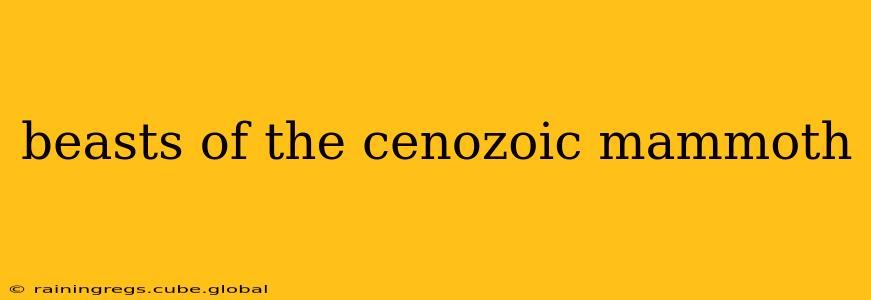The Cenozoic Era, spanning from 66 million years ago to the present, witnessed an incredible array of megafauna. Among the most iconic and recognizable of these colossal creatures is the mammoth, a genus of extinct proboscideans that roamed the Earth for millions of years. This post delves into the fascinating world of Cenozoic mammoths, exploring their evolution, diverse species, and eventual extinction.
What are the different types of mammoths?
Several mammoth species existed throughout the Cenozoic, each adapted to different environments and climates. Some of the most well-known include:
-
Woolly Mammoth (Mammuthus primigenius): Arguably the most famous mammoth, the woolly mammoth was adapted to the cold, icy conditions of the Pleistocene epoch. Its thick fur coat, small ears, and layers of fat provided excellent insulation against freezing temperatures.
-
Columbian Mammoth (Mammuthus columbi): A larger species than the woolly mammoth, the Columbian mammoth inhabited more temperate regions of North America. While possessing less insulation than its woolly cousin, it was still a formidable creature.
-
Imperial Mammoth (Mammuthus imperator): One of the largest mammoth species, the Imperial mammoth roamed North America during the Pleistocene. Its size and impressive tusks made it a dominant herbivore of its time.
-
Steppe Mammoth (Mammuthus trogontherii): This mammoth species is considered an ancestor to both the woolly and Columbian mammoths. It inhabited vast grasslands across Eurasia during the early to middle Pleistocene.
These are just a few examples; the mammoth genus was diverse, with several other species exhibiting unique adaptations to their respective environments.
When did mammoths live?
Mammoths first evolved in Africa during the Pliocene epoch (around 5 million years ago) and subsequently migrated across Eurasia and North America. Different mammoth species thrived throughout the Pleistocene epoch (2.6 million to 11,700 years ago), reaching their peak diversity and abundance during this period. The last woolly mammoths survived on Wrangel Island in the Arctic Ocean until roughly 4,000 years ago, making them among the last of the megafauna to disappear.
Where did mammoths live?
The geographic range of mammoths was extensive, encompassing much of the Northern Hemisphere. Fossil evidence indicates their presence in Africa, Europe, Asia, and North America. Their habitats varied depending on the species, ranging from grasslands and tundra to more forested areas. Adaptations like the woolly mammoth's thick coat allowed for inhabitation of even the coldest regions.
What did mammoths eat?
Mammoths were herbivores, primarily feeding on grasses, sedges, and other vegetation. Their large size and powerful tusks enabled them to access a wide range of food sources, even during harsh winters. Isotopic analysis of mammoth remains suggests seasonal variations in their diets, with certain plants being more prevalent at different times of the year.
Why did mammoths go extinct?
The extinction of mammoths is a complex issue with no single cause. The most widely accepted theory points to a combination of factors, including:
-
Climate Change: The end of the Pleistocene epoch brought significant shifts in climate, including warming temperatures and changing vegetation patterns. These changes likely impacted mammoth habitats and food sources.
-
Human Hunting: Humans coexisted with mammoths for a considerable period, and evidence suggests that hunting contributed to their decline. Overhunting, particularly during a period of already stressed resources, could have been a significant factor.
-
Disease: Although difficult to prove, outbreaks of disease may have also played a role in the decline of mammoth populations.
The interplay of these factors likely contributed to the ultimate extinction of mammoths, a dramatic event that reshaped the ecosystems they once inhabited. Understanding the extinction of mammoths serves as a cautionary tale regarding the impact of environmental changes and human activities on biodiversity.
